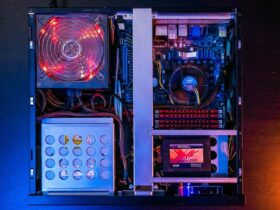Installing drivers without a CD or DVD can be a daunting task for many computer users. It can be difficult to find the right drivers, and even more confusing to figure out how to install them. But don’t worry! This step-by-step guide will show you how to install drivers without a CD, quickly and easily. With this guide, you’ll be able to download the correct drivers, update existing drivers, and install them in just a few simple steps. Whether you’re a novice or an experienced user, you’ll find everything you need to get up and running. So, let’s get started and learn how to install drivers without a CD.
How to Install Drivers Without CD?
Downloading Drivers Online
One of the most common ways to install drivers without a CD is by downloading them online. This is especially true if you are installing drivers for a printer, mouse, or keyboard. These devices generally don’t come with installation discs and are considered “plug and play”. Most plug-and-play devices will have a small switch or button on the device that you can press to make it work. If you’re having an issue installing a device that uses a driver, you should try searching online for that device and the corresponding driver. If you can find the driver, there is a good chance that you can install it without a CD.
Using a USB Flash Drive
One of the most common ways to install drivers without a CD is by using a USB flash drive. This is especially true if you are trying to install a printer driver on your computer. If you try to install the printer on your computer and it can’t find the driver, you can use a USB flash drive to install the driver and make the printer work. Simply plug in the USB flash drive to the computer and then open the printer properties and choose to install the driver from the USB flash.
Using Device Manager
Another one of the most common ways to install drivers without a CD is by using Device Manager. For this method, you will need to be on the computer where the device is not working properly. Open up the Start menu and then click on Device Manager. Once Device Manager is open, you should see a list of devices on your computer. If you can’t find the device that you’re having an issue with, expand the list of devices and choose to view hidden devices. Once you have found the device that is not working properly, right-click on it and choose to uninstall the device. Once the device has been uninstalled, click on “Scan for hardware changes” and the device manager will reinstall the device for you. If the device does not show up in the list once it has been reinstalled, check to see if the device is listed in hidden devices. If it is, you can manually choose to install the device.
Using Windows Update
Another one of the most common ways to install drivers without a CD is by using Windows Update. This method is really only helpful if the device that you are trying to install doesn’t have a driver. If you try to install a new device on your computer and the computer can’t find the correct driver, you can use Windows Update to install the driver. Once you have opened Windows Update, select “View available updates” and then “Download and install”. If there are any drivers available, they will be installed on your computer.
What are drivers and why are they important?
- Drivers are pieces of software that tell your computer how to interact with your hardware devices, such as your printer, mouse, keyboard, monitor, camera, etc. These drivers are required to make sure that everything interfaces correctly so that your computer can run smoothly.
- Without the correct drivers, your computer won’t know what to do with your devices. It’ll be like having a brand-new car with no keys. If you want to take it out for a drive, you need a set of keys. Drivers are that set of keys for your computer.
- If you don’t have the latest and correct drivers installed on your computer, you risk significant issues with your computer’s performance, functionality, and security.
- Without the latest drivers, your computer won’t be able to take advantage of the latest technology or software updates.
- Your computer may even stop working completely if you don’t have the correct drivers installed. This is especially true for devices like printers, scanners, and other hardware. So, it’s important to keep track of your drivers and update them when necessary.
How to download the correct drivers?
- The first step in installing drivers without a CD is finding the correct version of the driver for your computer. You can usually find the correct driver through your computer’s manufacturer’s website.
- Most computer manufacturers have a section where they list all of the required drivers and software. However, it can be difficult to find the correct drivers through this method. It’s likely that you’ll need to search for the driver by model number.
- Once you know the model number of your device, you can search for the driver using a search engine like Google. Here are a few tips to find the correct drivers:
- First, make sure you know the make and model number of the device you’re trying to update the driver for. You can usually find this information printed on the device itself or in your computer’s system information.
- Next, try searching for the make and model number of your device. If the make and model don’t work, try searching for the device type.
- Once you’ve found the correct driver, download the driver to your computer. You can usually do this by clicking the “Download” or “Download Now” buttons on the website.
How to update outdated drivers?
- If you’re installing drivers without a CD, chances are you’re updating an existing driver. To update a driver, you’ll need to find the driver on the website of the device’s manufacturer. Once you’ve found the correct driver, follow these steps:
- Open the Device Manager in your computer’s settings. This will allow you to view the current installed drivers and devices on your computer.
- Once the Device Manager is open, you’ll see all of the installed drivers and devices listed on the left side of the screen.
- On the right side of the screen, you’ll see the “Update Driver” button. Click this button and follow the on-screen instructions to update the driver.
Common errors while installing drivers
- There are a few errors that you may run into when trying to install drivers without a CD. Here are a few of the most common errors and how to fix them:
- Driver not found – If you get a “Driver not found” error, it usually means that the computer can’t find the driver you’re trying to install.
- If you’ve followed the steps outlined above, you may have a bad link. Try searching for the driver again and make sure you don’t click any links that look suspicious.
- The driver is corrupted or tampered with – If you receive an error message saying the driver is corrupted or tampered with, the driver may be infected with a virus. In this case, you should try using an antivirus program to scan and remove the malware.
- The driver is not for this operating system – If you get an error message saying the driver is not for your operating system, it means that the driver isn’t compatible with your version of Windows. You may need to update your version of Windows or find a different driver.
How to troubleshoot driver installation issues?
- If you’re encountering problems installing drivers without a CD, try a few troubleshooting steps to resolve the issue. Here are a few common problems and their solutions:
- You’re using the wrong drivers – This is a very common problem. To avoid installing the wrong drivers, make sure you’ve thoroughly researched the correct model number and brand name. Once you’re sure you have the right information, you can follow the steps outlined above to install the correct drivers.
- Your computer couldn’t download the correct driver – If your computer can’t download the correct driver, it may be because your internet connection is down. Once your internet connection is back up and running, try installing the driver again.
- Your computer couldn’t install the driver – If your computer can’t install the driver, it could mean one of a few things. Your computer may not have enough RAM to install the driver. Or, the driver may be corrupted. Try downloading the driver again and see if the issue persists.
Tips for successful driver installation
- Now that you know how to install drivers without a CD, here are a few tips to make sure everything goes smoothly:
- Make sure your computer is plugged in and connected to the internet. This will allow your computer to download the driver.
- If you’re having issues installing the driver, try uninstalling the old driver first. You can do this by clicking the “Update Driver” button in the Device Manager.
- If you’re installing a driver for a new device, make sure the device is plugged in and turned on. This will ensure that your computer can communicate with the device and install the driver properly.
Conclusion
Once you know how to install drivers without a CD, you’ll be able to install new drivers whenever they’re released. And if you ever lose your driver CD, at least you know how to get your computer back up and running.
























Leave a Reply